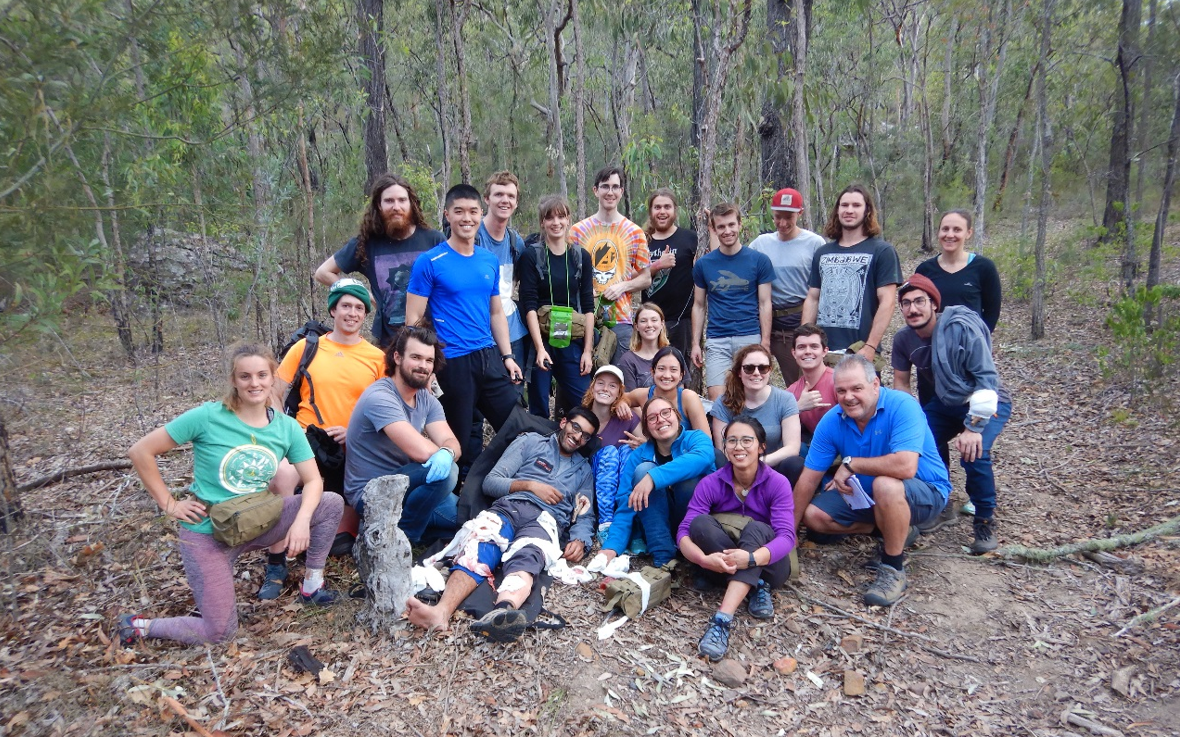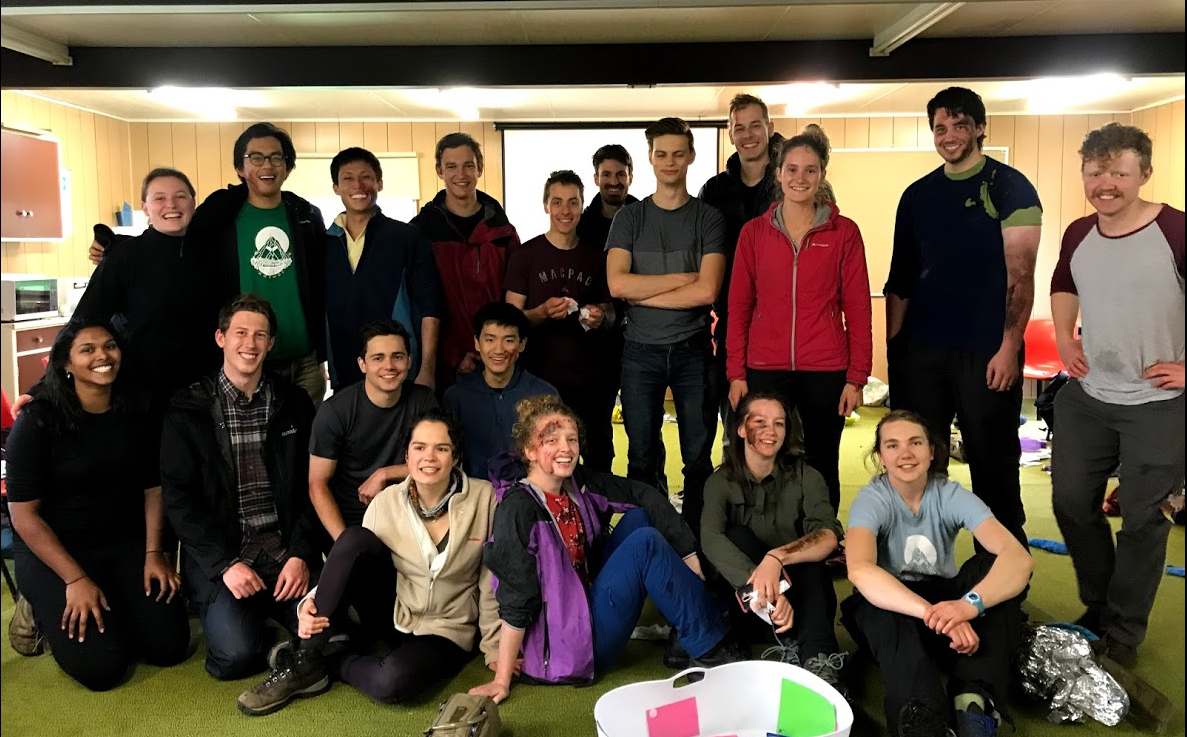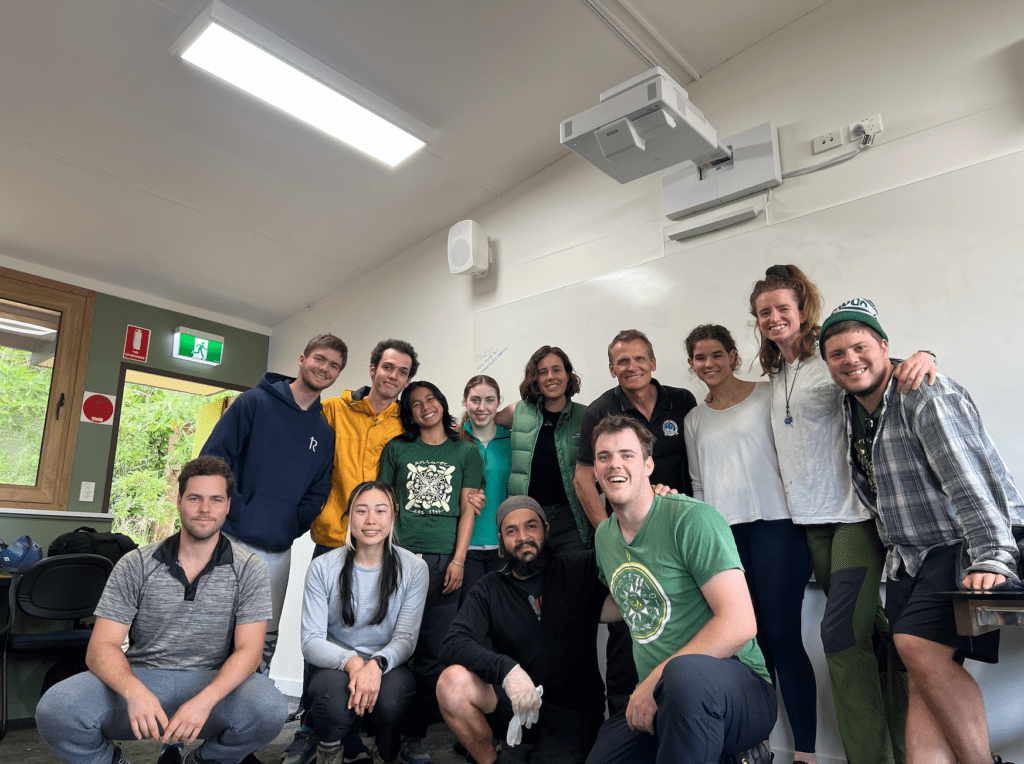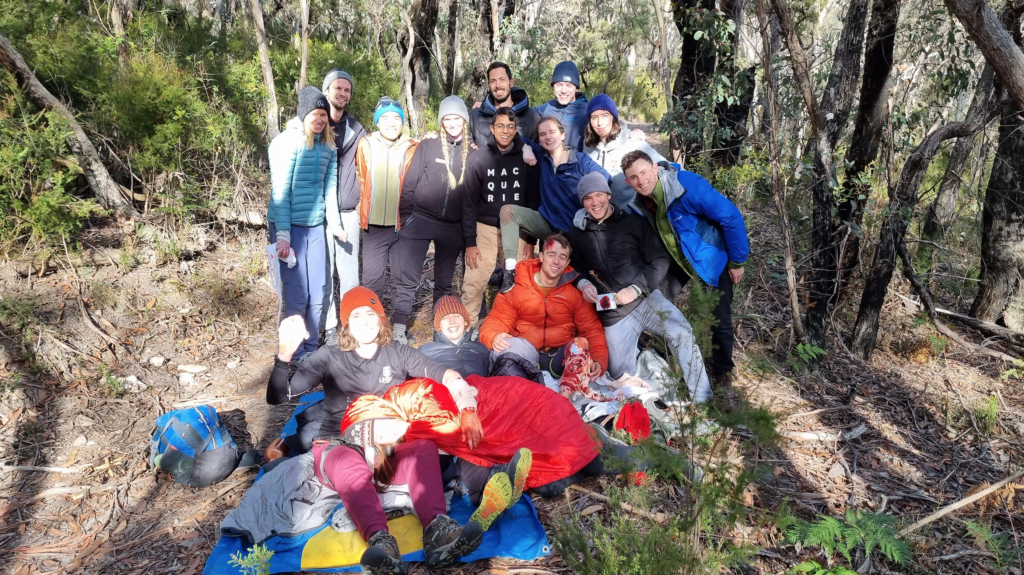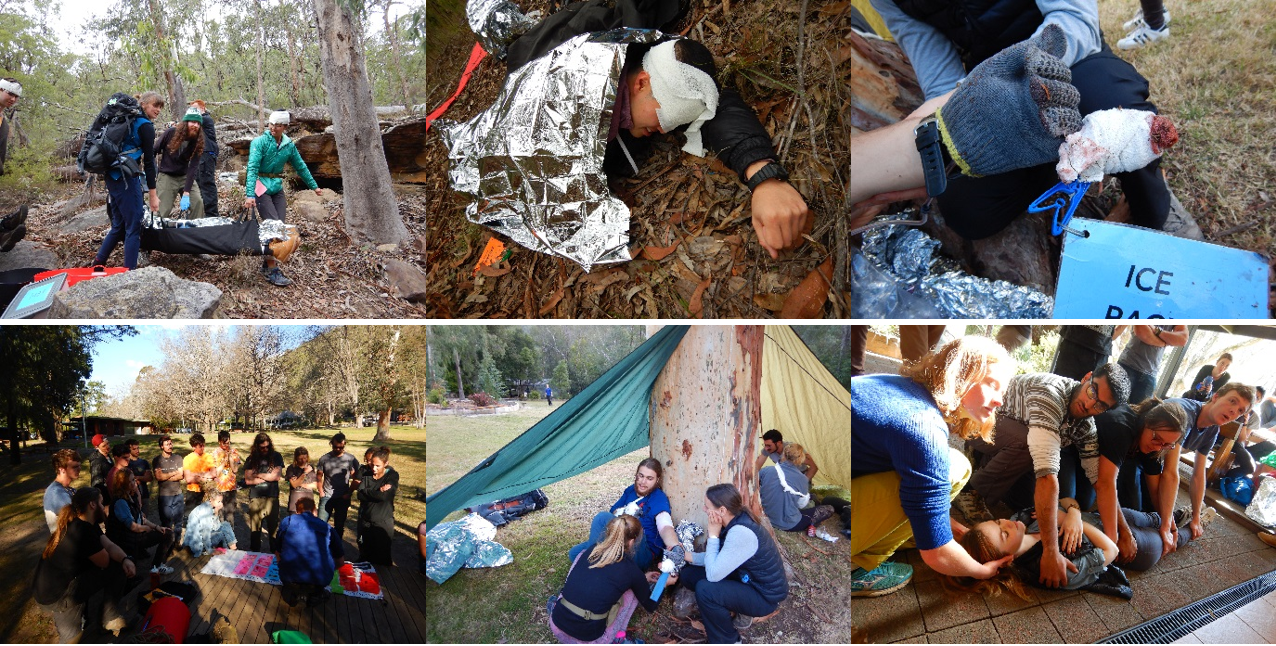The UNSWOC is committed to train their Trip Leaders in Remote Area First Aid (RAFA), an essential skill to have when leading trips in the outdoors. The following report includes useful advice on what to do regarding common outdoors injuries. For full training, please consider doing a RAFA course.
28-29th July 2018
AllAid First Aid (https://www.allaid.com.au/) at Camp Somerset
Participants: Lucy Morrison, Maria Lastra Cagigas, Mira Jordan, Isabella Lowe, Stefanie Tenberg, Ben Wilkinson, Hayden Lobry, Tadeh Karapetian, Abi Prakash, Vicky Chen, Henry Burt, Mackenzie Labine-Romain, Eamonn Colley, Ashley Brennan, David Temesvary, Sid Tinney, Manon Nyssen, Nicola Tan, Liam Hayes and Luke Robbins.
12-13th October 2019
AllAid First Aid (https://www.allaid.com.au/) at North Turramurra
Participants: Aidan Cameron, Alexandra Repetto, Ava Del Tufo, Beth Howlett, Brendon Yiu, Evie Wilkins, Glenn Southern, Greta Ritchard, Jeffrey Kwan, Jenny Stansby, Joshua Yang, Liam Viney, Matthew Notarangelo, Nathan Jensen, Nick Fabian, Nicolas Di Campli, Oliver Nicholls, Scott Koppelhuber, Stephen Roche, Yvette Mascarenhas.
December 2021
Participants: Ashleigh Ford, Beth Howlett, Brendan Conneely, Jenny Stansby, Juri Hemmi, Maria Lastra Cagigas, Mira Jordan, Nadav Cohen, Nat Shroeder, Oliver Nicholls, Stephen Roche
6-9th February 2023
Wilderness First Aid Australia (https://www.wildernessmedicine.com.au/) at Mount Victoria
Participants: Amelia Kaag, Angela Ha, Brendan Conneely, Gabriel Dickinson, Georgie Clare, Jayden Maisel, Katie Wilson, Linna He, Mali Woods, Nadav Cohen, Samantha Millard, Zenon Platritis
26-28th May 2023
Wilderness First Aid Australia (https://www.wildernessmedicine.com.au/) at Mount Victoria
Participants: Amelia Vasiliou, Bennett Frerck, Caitlin Donovan, Felix Kibblewhite, Daniel Gilbert, Krishna Srivastava, Lloyd Siharath, Maddi Dunster, Margot Mason, Ryan Van Dyk
17th June 2023
A First Aid Simulation Day was run by Katie and Oliver to share, retain and regain First Aid and Situational Management skills with club members and trip leaders. Check out the blog post below!
2018 Remote Area First Aid Course: Summary
We arrived at Camp Somerset early on Saturday morning, wearing comfortable outdoors clothes and ready for a full weekend of learning and challenges. After a cup of tea, our instructors from AllAid First Aid welcomed us and started the Remote Area First Aid training.
We reviewed the basic concepts of First Aid in the classroom: starting with the DRSABCD approach (Danger, Response, Send for help, Airways, Breathing, CPR, Defibrillator), following with COWS (Can you hear me?, Open your eyes, What’s your name?, Squeeze my hand), checking for Airways > Bleeding > Spinal and placing the patient in Recovery Position. We learnt how to measure the Functional Vitals (Pulse, Breathing, Level of Consciousness, Skin colour-temperature-moisture, Posture and Pain), how to do a Head to Toe Assessment, and how to sample the patient’s body. We practised CPR (cardiopulmonary resuscitation) and learnt to use a defibrillator.
Afterwards, we prepared our First Aid kits and Responder backpacks, split the group into responders and casualties and got ready for the scenarios. During the 8 scenarios practised over the weekend, the casualties mimicked a set of medical conditions that needed urgent treatment: >2m fall with suspected spinal injury, diabetic coma, hypothermia leading to shock, head bleeding, leg and arm injuries, sprains and fractures, severe arterial bleeding, asthma attacks, snake and spider bites, seizures, blocked airways, anaphylactic reactions, bonfire burns, dehydration, exhaustion, and heat shock, among others.
The responders were contacted via radio and were asked to immediately find the casualties in the outdoors and provide adequate first aid. We learnt how to treat all the previously mentioned conditions, how to contact the base via radio for environmental updates, and how to perform an evacuation to “road” and “expedite”. The responders worked alone, in pairs, in small teams and as a big group, learning how to lead a team, delegate tasks and respond efficiently.
During the scenarios, we faced worsening environmental conditions that we had to deal with such as river flooding, increasing smoke presence from a bonfire, and unexpected rain and stormy conditions that required us to build a shelter, among others.
Following every scenario, we had an interactive discussion with our instructors and reflected on how we faced the situation, what feelings, insecurities or fears we encountered, and what approach was the most successful. We set goals for the next scenarios to improve our response.
We also re-practised the appropriate treatments to the medical conditions, carefully learning how to apply a bandage over bleeding injuries, a tourniquet, a snake compression bandage, a bandage over an embedded object or a protruding bone, an arm splint and sling, how to inject intramuscular adrenaline, use a puffer and asthma reliever spacer, adjust an angulated femur fracture, treat blisters, immobilise and transport a patient with spinal injury, treat burns with recycled flowing water, tape up a sprained ankle, isolate the patient from cold or hot temperatures, among others.
By the end of the weekend, all the participants felt comfortable and confident providing First Aid in the outdoors and agreed that the training course was extremely useful, valuable and very closely related to all the outdoors activities we organise as Trip Leaders from the UNSWOC. All the participants completed their Remote First Aid Course Walk-book and certified in HLTAID001 (Provide CPR), HLTAID003 (Provide first aid) and HLTAID005 (Provide first aid in remote situations). Lastly, the UNSWOC Executive Team would like to thank Arc for their valuable support and funding.
Remote Area First Aid Course: Skill Transfer
Following the completion of this course, the UNSWOC organised a free “First Aid Focused on the Outdoors Practical Workshop” open to any UNSWOC member for them to learn the basics of Remote Area First Aid. The current UNSW Executive Team is committed to run this workshop every semester to increase the overall first aid knowledge of the club and to build a safer, more competent and more confident outdoors community. This workshop ensures that the UNSWOC and all its members make the most out of the funding we receive, it expands the horizons of our training, and it demonstrates the commitment of the UNSWOC with safety in the outdoors. We covered the following scenarios:
-
Scenario: Unconscious patient
Follow the DRSABCD approach: Check for danger to yourself, your team and the patient, in that order (D). Check for a response (R): Get close to the patient and use the COWS approach. Ask them firmly if they can hear you (C), ask them to open their eyes (O), ask them what’s their name (W), and ask them to squeeze your hand (S). If you get a spoken response, the patient is breathing and conscious. If you only obtain a tactile response, the patient is conscious and has a pulse and may or may not be breathing. Depending on the response, you may consider sending for help (S). If you don’t obtain a response, send for help. Delegate on a third person to send for help if possible.
If the patient does not respond or breathing is not apparent, immediately check their airways (A). To do this, place the patient in recovery position, open their mouth and visually inspect the cavity. You may use their fingers to explore their mouth. In the event of blocked airways, recovery position may unblock them, and breathing may be restored to normal. If their airways are clear but breathing has not been restored, check for breathing (B). Look at their chest, it should rise and lower; listen to their breath, it should make a soft noise; feel their breath by placing your hand underneath the ribs over the diaphragm. If the patient is breathing, check for bleeding (section II). If the patient is not breathing, perform CPR (C): open their airways by tilting their head, and complete 30 chest compressions followed by 2 breaths. CPR must keep going until breathing is restored unless medical services say otherwise unless there is an incoming danger that justifies the CPR to stop or unless the person providing CPR suffers from exhaustion. If possible, always use a defibrillator to complement the CPR (D).
-
Scenario: Bleeding
If the airways are clear and the patient is breathing, the next priority is bleeding. If the bleeding is not obvious to the eye, perform a thorough head to toe assessment. Wear gloves if available. Starting at the head, feel and slightly press the head, neck, clavicles, shoulders, chest, ribs, pelvis, arms, hands, fingers, legs, knees, feet and toes. Compare right and left-hand side looking for any abnormal tissue. Look down at your gloves looking for blood that may be masked by dark clothing. If the patient is conscious, talk them through the assessment asking for pain. If the person is unconscious, keep assessing until bleeding or fractures and any abnormal tissue are found. If bleeding is not observed, got to section III. If bleeding is observed, try to identify whether it is arterial (from arteries) or non-arterial (from veins and capillaries) bleeding.
Arterial bleeding may be very dangerous and lead to severe blood loss and potential death within minutes. Non-arterial bleeding may cause slower blood loss and may be less critical. In both cases, apply pressure immediately using a wound pad over the wound. Apply a bandage over the wound pad compressing the source of bleeding. When possible, raise the area above the heart. If bleeding does not stop, apply more pressure with another bandage on top and make it tight. Sufficient pressure should stop the most bleeding.
If bleeding is extremely copious, life-threatening and over 2 l of blood have been lost, consider sending for help and tourniquet the limb. If bleeding occurs on the arm, find the brachial artery to apply a tourniquet; if it occurs on the leg, find the femoral artery to tourniquet. To apply a tourniquet, wrap a triangle sling around the artery and use a stick or equivalent to tight it up. Stop when the patient feels pain and make a knot to fix the tourniquet. Once on, the tourniquet should not be removed in the following 8 hours. Serious bleeding may lead to shock: you may consider treating for shock by keeping the patient warm (remove wet or cold clothes) and isolated from wet or cold ground in a safe and comfortable position.
-
Scenario: Spinal and other fractures
If the head to toe assessment concluded that the patient is not bleeding, the next priority is a spinal fracture and other fractures. If the patient has fallen >1.5m, you may suspect a spinal injury. Designate a person to protect and support their spine by carefully placing their hands underneath the patient’s head and neck. In the event of a spinal injury, you may consider sending for help and evacuating.
If the patient can move their body without major complications, does not have any back pain and has not fallen, a spinal injury may not be present. However, the head to toe assessment may reveal other common fractures such as ankle sprains or broken arms.
For an ankle fracture, tape it up for support if the patient needs or can keep walking or apply a compression bandage if there is swelling and the patient cannot walk. For a fractured arm, apply an elevation sling to support the weight of the arm. For burns, apply cold running water for 20 min and cover the burns with a non-adherent dressing such as plastic wrap. Do not use ice on a burnt area or remove any clothing attached to it.
-
Scenario: Pre-existent Medical Conditions
If the head to toe assessment concluded that there are no spinal or other fractures, you may consider pre-existing medical conditions. The trip leaders must always ask their participants about pre-existing medical conditions, their triggers and their medications. No trip should be undertaken without carrying the appropriate medications and knowing how to use it and what dose to apply.
If the patient presents extreme tiredness, severe thirst despite having drunk enough water, abdominal pain, nausea or vomiting, dizziness and loss of coordination, persistent headache, pale or sweaty skin and can seem drunk, they may suffer from diabetes. If the patient is conscious, give them sugar or equivalent unless they can monitor themselves and are familiar with how to proceed. If the patient is unconscious, place some little sugar on their fingertips and rub them against their inner cheek. Do not give them insulin. Monitor their functional vitals and be prepared to start CPR if they stop breathing.
If the patient presents swelling of the face, mouth, throat and eyes, redness of the skin over the chest and back, nausea and vomiting, breathing difficulty, dizziness and weakness or collapse, they may suffer from an anaphylactic reaction. If possible, find and give their prescribed medication (EpiPen or equivalent). To use an EpiPen, pull off the blue safety release from the top and place the orange end hard into the outer thigh so it clicks, and hold for 10 seconds. Place them in recovery position and rest. Monitor their functional vitals and be prepared to start CPR if they stop breathing.
If the patient is unable to get enough air, short of breath, progressively become more anxious, focused only on breathing, coughing, wheezing, and their lips, earlobes and fingertips turn blue, they may suffer from an asthma attack. If possible, find and give their prescribed medication (puffer or equivalent - 4 inhalations every 4 min), sit them upright, make sure they take long, deep breaths and stay calm. If possible, get away from the trigger. Monitor their functional vitals and be prepared to start CPR if they stop breathing.
-
Scenario: Bites
If the head to toe assessment concluded that there are no spinal or other fractures, and there are no symptoms of pre-existent medical conditions, you may repeat the head to toe assessment again looking for bites. You may recognise a bite for pain and swelling around the bite, an altered sensation (e.g. pins and needles), blurred vision, muscle weakness or paralysis, or a possible anaphylactic reaction.
Bites may cause just a physical injury (dogs, most ants, most spiders, most mosquitoes, etc.). In this case, you may treat the bite as a regular wound: clean the area and apply a wound pad and a bandage. Depending on the type and size of the bite, beware of possible infection or severe bleeding and treat accordingly.
Bites may also cause a physical injury plus a venomous injection (some bees, wasps, spiders and snakes). In this case, the venom must be stopped and prevented from getting to your blood, and therefore your heart and brain where it may cause heart or brain arrest and imminent death. For any venomous bite, the priority is to keep the patient completely still and relaxed, so their muscles do not perform any work to prevent the lymphatic system from moving the venom around the body. If the bite comes from a bee or wasp, remove the barb immediately and apply a compression bandage. If the bite comes from a snake or a spider, use a compression bandage. To apply a compression bandage, start from the bite to the fingertips, then from the fingers back to the shoulder, and from shoulder back to the bite.
Cheers, Maria




